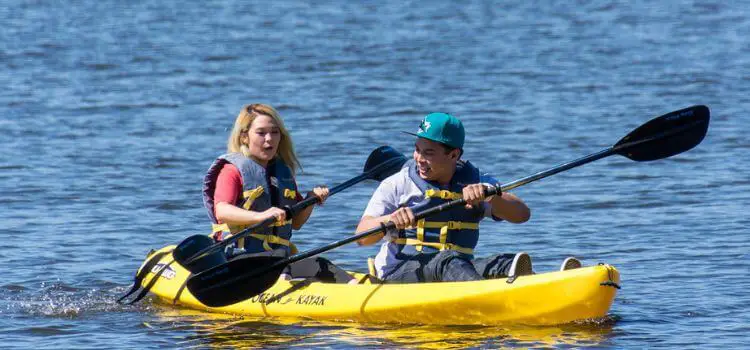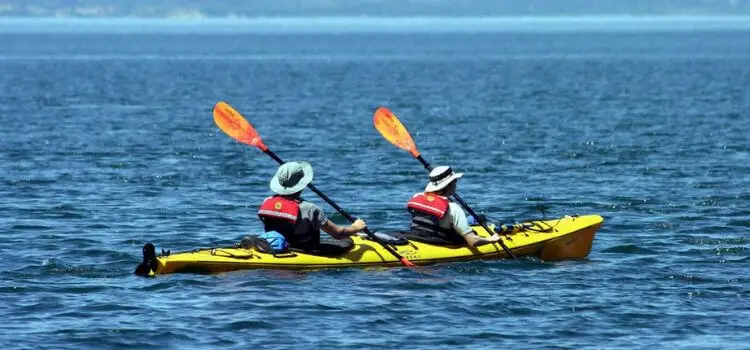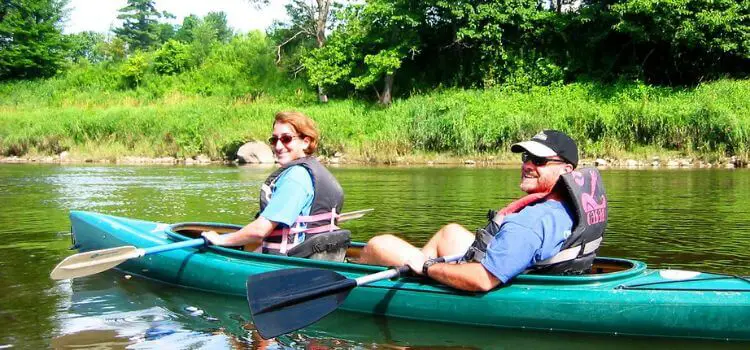As an Amazon Associates, I earn from quality purchases.
Are you curious about the world of kayaking? If you’ve ever pondered, “What is a tandem kayak?” you’ve come to the right place. In this article, we’ll explore the ins and outs of tandem kayaks and uncover the excitement they offer.
Whether you’re a beginner looking to embark on your first kayaking adventure or an experienced paddler seeking a unique experience on the water, understanding what a tandem kayak is and its benefits will broaden your horizons.
By exploring the wide range of tandem kayak options, you can select the perfect vessel that suits your preferences and embark on unforgettable aquatic adventures.
Join us as we dive into the world of tandem kayaking. Discover why this dynamic watercraft is gaining popularity among paddling enthusiasts.
What is a Tandem Kayak?

A tandem kayak is a watercraft designed to accommodate two or more paddlers. It provides a platform for shared exploration, adventure, and enjoyment on the water. The unique aspect of a tandem kayak is its ability to bring people together in a collaborative paddling experience.
Key Features and Characteristics of Tandem Kayaks:
Size and Design:
Tandem kayaks are characteristically long and wide compared to solo kayaks. They give increased stability and weight capacity. They are designed to evenly distribute the weight of multiple paddlers. Tandem kayaks provide ample space for comfortable seating.
Seating Arrangement:
Tandem kayaks feature two or more seats positioned side by side or in a tandem configuration. They allow paddlers to face forward and paddle in sync. Some models also offer adjustable seating positions to accommodate paddlers of different sizes.
Footrests and Bracing:
Tandem kayaks are equipped with adjustable footrests or foot braces for each paddler. These provide stability, proper body positioning, and enhanced control during paddling strokes.
Storage Space:
Tandem kayaks often have ample storage compartments. There are front and rear hatches, deck bungee cords, and storage wells. This allows paddlers to bring along gear, supplies, and personal belongings for extended trips or day excursions.
Stability:
Tandem kayaks are designed to offer increased stability compared to solo kayaks. The wider hull and longer length contribute to a balanced and steady ride. They are suitable for beginners or those seeking a more relaxed paddling experience.
Maneuverability:
Tandem kayaks may require more coordination between paddlers. They are designed to maintain maneuverability and responsiveness on the water. With proper communication and synchronized paddling techniques, tandem kayaks can navigate through various water conditions.
Weight Capacity:
Tandem kayaks have higher weight capacities compared to solo kayaks. They allow for the inclusion of extra gear or passengers. This makes them versatile for recreational outings, fishing trips, or even multi-day expeditions.
Benefits of Using a Tandem Kayak:

Collaboration and Bonding:
Tandem kayaking fosters teamwork, communication, and a shared sense of accomplishment. Paddlers work together to navigate, steer, and propel the kayak. Thus, they strengthen relationships and create memorable experiences.
Enhanced Efficiency:
With two paddlers, a tandem kayak can cover more distance with less effort. By sharing the workload, paddlers can maintain a steady pace and extend their paddling duration.
Support for Beginners:
Tandem kayaks can be an excellent choice for beginners. They offer stability and a learning platform with a more experienced partner. Novice paddlers can gain confidence. They can improve their skills while receiving guidance from their tandem companion.
Increased Safety:
Tandem kayaking provides an additional level of safety. Having a partner by your side allows for quicker help in case of emergencies or unexpected situations on the water.
Social Enjoyment:
Tandem kayaking enables shared conversations, laughter, and a sense of camaraderie between paddlers. It offers a social and recreational experience. It also enhances the joy of being on the water together.
Overall, tandem kayaks provide a unique way to connect with nature, share adventures, and build relationships.
Types of Tandem Kayaks
Tandem kayaks come in various types and designs, catering to different preferences and paddling environments. Let’s explore the different options available and discuss the variations in size, shape, and materials used.
Sit-On-Top Tandem Kayaks:
Sit-on-top tandem kayaks feature an open deck design with molded seats on top of the kayak’s hull.
These kayaks are popular for recreational use. They offer ease of entry and exit, excellent stability, and self-bailing capabilities.
Sit-on-top tandems are often made of durable and UV-resistant materials like rotomolded polyethylene. They ensure longevity and resistance to the elements.
Sit-In Tandem Kayaks:
Sit-in tandem kayaks feature a closed cockpit design. Here, the seats are positioned inside the kayak’s hull.
These kayaks provide increased protection from water splashes, waves, and weather conditions. They are suitable for colder climates or rougher waters.
Sit-in tandems are available in various materials such as polyethylene, fiberglass, or composite materials. They offer a balance between durability and performance.
Inflatable Tandem Kayaks:
Inflatable tandem kayaks are portable and lightweight. You can easily transport and store them.
These kayaks are typically made from durable PVC or drop-stitch materials. They provide rigidity when inflated.
Inflatable tandems offer excellent stability and buoyancy. They are suitable for recreational paddling in calm waters or mild river conditions.
Touring Tandem Kayaks:
Touring tandems are designed for longer paddling excursions and expeditions. They offer enhanced performance and efficiency.
These kayaks are sleeker, longer, and narrower compared to recreational tandems. They have improved speed and tracking systems.
Touring tandems often feature additional storage compartments, deck rigging, and advanced seat adjustability to accommodate multi-day trips and gear requirements.
Materials used for touring tandems can include fiberglass, Kevlar, or carbon fiber. They have a lightweight construction and increased maneuverability.
Fishing Tandem Kayaks:
Fishing tandems are specially designed with angling features, such as built-in rod holders, storage for tackle boxes, and mounting options for fish finders or other fishing accessories.
These kayaks offer stability and ample deck space. They also have features like adjustable seats and specialized rigging for fishing gear organization.
Fishing tandems are typically constructed with durable materials like rotomolded polyethylene. They withstand the rigors of fishing environments.
Each type of tandem kayak offers distinct advantages and considerations. It is essential to assess your paddling goals, intended use, and personal preferences when choosing the right tandem kayak for your adventures.
The Difference between a Solo Kayak and a Tandem Kayak
When it comes to kayaking, there are two primary options to consider: solo kayaks and tandem kayaks. They both offer unique experiences on the water. But, there are distinct differences in their features, functionalities, and overall paddling dynamics. Let’s compare and contrast these two types of kayaks and highlight the advantages and disadvantages of each.
Solo Kayaks:
Features and Functionality:
Solo kayaks are designed to accommodate a single paddler. They typically have a compact and streamlined design. This design allows for increased maneuverability and agility on the water.
Solo kayaks come in various styles, including recreational, touring, and whitewater kayaks. Each one of them is tailored to specific paddling preferences.
Advantages:
Independence and Control:
Solo kayaks offer complete control over maneuvering and navigation. They allow paddlers to paddle at their own pace and explore independently.
Easier Transport and Handling:
Solo kayaks are generally lighter and more manageable. They are easier to transport, launch, and carry.
Versatility:
Solo kayaks provide versatility in terms of paddling destinations. They can navigate narrow waterways, rocky rivers, and even ocean surf.
Disadvantages:
Limited Carrying Capacity:
Solo kayaks have limited space for gear. It can be a constraint for longer trips or when carrying larger amounts of equipment.
Less Social Interaction:
Paddling alone may limit social interaction. It can also reduce the shared experience of exploring the waterways with others.
Tandem Kayaks:

Features and Functionality:
Tandem kayaks are specifically designed to accommodate two or more paddlers. They have a wider and longer hull. They provide stability and weight capacity for multiple occupants. Tandem kayaks often have adjustable seating positions to accommodate paddlers of different sizes.
Advantages:
Collaboration and Teamwork:
Tandem kayaks foster teamwork and collaboration between paddlers. Communication and coordinated paddling strokes enhance efficiency and propel the kayak forward.
Enhanced Stability:
Tandem kayaks offer increased stability due to their wider hull design. They are suitable for beginners or those seeking a more relaxed paddling experience.
Shared Experience:
Tandem kayaking allows for shared conversations, laughter, and the joy of experiencing nature together. It is an excellent choice for couples, friends, or families.
Disadvantages:
Coordination Challenges:
Tandem kayaking requires coordination and synchronization between paddlers. It may take time to establish rhythm and communication, especially for novice paddlers.
Potential for Conflicts:
Differences in paddling style, pace, or direction can lead to conflicts or disagreements between tandem kayakers if proper communication and teamwork are not established.
Both types have their advantages and considerations. Ensuring that you can find the perfect kayak to suit your desired paddling style and the water environments you wish to explore.
How Does a Tandem Kayak Work?
Tandem kayaks operate on a simple yet effective mechanism that allows two or more paddlers to work together in navigating the water. Understanding the basic mechanics of a tandem kayak and how paddling and steering are managed is essential for a smooth and enjoyable kayaking experience.
Shared Seating and Paddling:
- Tandem kayaks feature seating positions that are either side by side or in a tandem configuration. The paddlers sit facing forward, with each person holding a paddle.
- To propel the tandem kayak, the paddlers coordinate their paddle strokes. This involves paddling on opposite sides of the kayak. It ensures that the paddles enter and exit the water simultaneously.
- Synchronized paddling allows for an efficient transfer of power. It propels the kayak forward in a straight line or the desired direction.
Steering and Maneuverability:
- Steering a tandem kayak requires effective communication and coordination between the paddlers.
- The rear paddler often takes on the role of the “stern paddler”. He is responsible for steering and maintaining the kayak’s course.
- The stern paddler can control the direction by using their paddle as a rudder. By placing the paddle in the water and using it as a steering aid, they can make subtle adjustments to the kayak’s heading.
- Communication is key in tandem kayaking. The stern paddler can provide directions or signals to the bow paddler, indicating the desired course adjustments or changes in speed.
- It is important for both paddlers to communicate and work together, adjusting their strokes and making coordinated maneuvers to ensure the kayak responds to their intentions.
Weight Distribution and Balance:
- Proper weight distribution is crucial for maintaining balance and stability in a tandem kayak.
- Paddlers should aim to distribute their weight evenly across the kayak to maintain equilibrium and prevent the kayak from tipping to one side.
- In situations where one paddler is significantly lighter or stronger than the other, adjustments in paddling intensity or technique can be made to maintain balance and avoid veering off course.
- Communication and trust between the paddlers are important. It will ensure weight distribution and balance are maintained throughout the kayaking journey.
Sharing the responsibility of paddling and steering enhances the overall experience. It allows for a seamless and enjoyable tandem kayaking adventure.
Why Use a Tandem Kayak?

Tandem kayaks offer numerous advantages for various activities. They provide a unique kayaking experience that goes beyond solo paddling.
Let’s explore the benefits of using a tandem kayak. And, also highlight the social and collaborative aspects that make tandem kayaking a popular choice.
Shared Experience and Bonding:
- Tandem kayaking provides an opportunity to share the experience with a partner, friend, or family member. It creates lasting memories and strengthens relationships through shared adventures on the water.
- The social aspect of tandem kayaking allows for conversations, laughter, and the joy of exploring nature together. It fosters a sense of camaraderie and teamwork, enhancing the overall enjoyment of the activity.
Enhanced Efficiency and Speed:
- Tandem kayaks benefit from the combined power of two paddlers. With synchronized paddling and coordinated strokes, tandem kayaks can achieve higher speeds and cover more distance compared to solo kayaks.
- The efficiency of tandem kayaks is particularly advantageous during long paddling trips or when facing challenging water conditions. Paddlers can take turns and support each other. It will reduce fatigue and increase overall endurance.
Beginner-Friendly Option:
- Tandem kayaks are often recommended for beginners. They may feel more comfortable paddling with a partner. The stability of tandem kayaks, combined with the assistance and guidance from a more experienced paddler, can provide a safe and reassuring introduction to kayaking.
- Beginners can learn from each other. They can share paddling techniques, and develop their skills together. They can build confidence and foster a supportive learning environment.
Versatile Use:
- Tandem kayaks are suitable for various activities. For example, recreational paddling, exploring lakes and calm rivers, fishing excursions, etc.
- The increased weight capacity and storage options in tandem kayaks allow for carrying more gear.
- They are ideal for longer trips where additional equipment or supplies are necessary.
Safety and Support:
- Tandem kayaking provides an added sense of security. There is someone else in the kayak who can assist in case of emergency or unexpected situations.
- In rough or challenging waters, having two paddlers offers increased stability and balance. It will be easier to navigate and maintain control of the kayak.
With the added advantage of improved speed, versatility, and the ability to carry more gear, tandem kayaking opens up a world of possibilities for adventurous water enthusiasts.
Are Tandem Kayaks Safer?
Tandem kayaks offer several advantages that make them a reliable and secure choice for paddlers. Let’s address the safety aspects associated with tandem kayaks:
Stability:
- Tandem kayaks are generally more stable than solo kayaks. They have a wider hull design and increased width than kayaks.
- The wider base provides better stability. It is less likely for the kayak to tip or capsize, especially in calm or mild water conditions.
- This added stability can be particularly beneficial for beginners or those who may feel less confident in maintaining balance on their own in a solo kayak.
Rescue Techniques:
- Tandem kayaks offer the advantage of having two paddlers. It can aid in rescue situations.
- In the event of a capsize, one paddler can assist the other in reentering the kayak or performing a rescue maneuver.
- Tandem kayakers can collaborate in self-rescue techniques. Such as the T-rescue or paddle-float rescue. It provides an extra layer of safety and support during emergencies.
Safety Precautions:
Just like with any water activity, it is important to follow safety precautions when using a tandem kayak:
Personal Flotation Devices (PFDs):
Both paddlers should always wear properly fitted PFDs. It will ensure buoyancy and personal safety.
Communication and Coordination:
Clear and effective communication between tandem kayakers is crucial for safety. Establish signals and pre-determined communication methods to communicate intentions, hazards, or changes in course.
Proper Gear and Equipment:
Ensure that you have the necessary gear. For example, paddles, bilge pumps, and signaling devices, in case of emergencies. Additionally, secure any loose gear to prevent it from shifting or falling overboard.
Weather and Water Conditions:
Pay attention to climate foretelling. Understand the water conditions before heading out. Avoid kayaking in extreme weather conditions or when the water is rough and beyond your skill level.
Skill Development:
- To maximize safety, it is important for both paddlers to have some level of kayaking skills and knowledge.
- Familiarize yourself with basic kayaking techniques. For example, proper paddling strokes, bracing, and turning maneuvers. It will enhance your control and safety on the water.
- Practice self-rescue techniques. Learn how to assist each other in case of an emergency. Building these skills will increase your confidence and ability to handle unexpected situations.
Tandem kayaks offer inherent stability and the potential for improved safety. It is also essential to focus on safety precautions, communication, and skill development. Remember, safety should always be a top priority to ensure a positive and secure kayaking adventure.
Conclusion
Tandem kayaks offer a remarkable kayaking experience. It combines the joys of teamwork, shared adventures, and enhanced performance on the water.
Throughout this article, we have explored the concept of tandem kayaking and delved into its various aspects.
So, gather your partner or a companion, embrace the collaborative spirit, and embark on a tandem kayaking adventure.
Discover the wonders of nature, explore picturesque waterways, and create unforgettable memories as you paddle together in perfect harmony.
The world of tandem kayaking awaits promising excitement, companionship, and a lifetime of cherished moments on the water.
Frequently Asked Questions (FAQs):
Q: Can 1 person use a 3 person kayak?
While one person can use a three-person kayak, it is not recommended. It is generally more efficient and manageable to use a kayak specifically designed for solo paddling.
Q: Which kayak is best for beginners?
Sit-on-top kayaks are often considered the best option for beginners. They offer stability, easy entry and exit, and a forgiving nature in terms of balance.
Q: What is the maximum weight for a person to kayak?
The maximum weight capacity of a kayak varies depending on its size, design, and materials. Most recreational kayaks have weight capacities ranging from 250 to 400 pounds (113 to 181 kilograms).
Q: Is a tandem kayak faster?
Tandem kayaks, with two paddlers working in sync, have the potential to be faster than solo kayaks. The combined power and coordinated strokes of the two paddlers can propel the tandem kayak to higher speeds and cover more distance.
Q: Can a tandem kayak sink?
Tandem kayaks are designed with buoyancy and stability. They are highly unlikely to sink under normal circumstances. However, it is important to consider the weight capacity of the kayak and avoid exceeding its limit.
You may also read: How To Transport a Kayak on A Car?

Leave a Reply